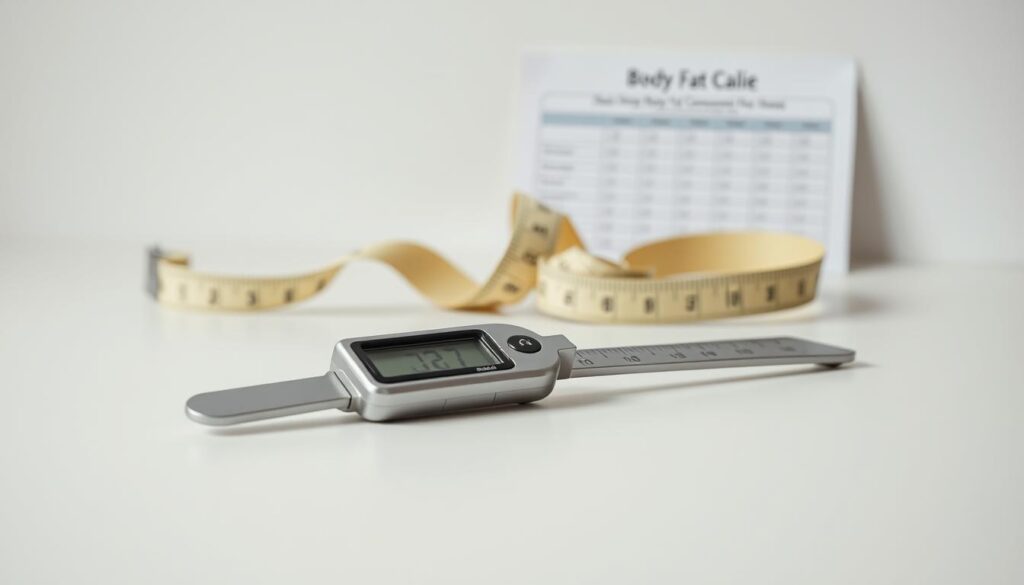What if the secret to better health isn’t just your weight? While many focus on the scale, your body fat percentage reveals far more about your fitness and risks for chronic conditions. Let’s explore why this metric matters—and how you can track it without expensive gadgets.
Your fat percentage reflects the ratio of fat to lean mass, offering insights no basic scale can. High levels correlate with heart disease and diabetes, while low percentages may signal hormonal imbalances. But how do you monitor this without lab tests? We’ve curated simple, science-backed techniques anyone can try.
From skinfold calipers to smart scales, affordable tools now make it easier to estimate body composition in minutes. Pair these with BMI calculations for a fuller picture of your wellness. Remember: knowledge is power. Understanding these numbers helps you set realistic goals and celebrate progress.
Key Takeaways
- Body fat percentage provides deeper health insights than weight alone.
- At-home methods like calipers or bioelectrical impedance offer practical tracking.
- Combining metrics (e.g., BMI and waist measurements) enhances accuracy.
- Regular monitoring helps identify trends and adjust fitness strategies.
- Guidelines from trusted sources ensure methods are safe and reliable.
Understanding Body Fat and Its Importance
Body composition tells a story that scales can’t capture. While weight gives a basic snapshot, fat percentage reveals how much of that mass supports vital functions versus storing excess energy. This distinction helps explain why two people with identical weights can have vastly different health profiles.
Health Risks Linked to Excess Body Fat
Carrying too much fat strains nearly every system. Studies show a 32% higher risk of heart disease in adults with elevated levels, according to research from the British Heart Foundation. Excess fat also disrupts insulin function, doubling diabetes odds in some cases. Even joints suffer—every extra pound exerts four pounds of pressure on knees.
The Role of Fat Distribution in Overall Health
Where fat settles matters more than total amount. Apple-shaped individuals with waist-centered fat face higher risks than those storing it in hips or thighs. Why? Visceral fat around organs releases inflammatory chemicals linked to:
- High blood pressure
- Liver disease
- Certain cancers
Men with waists over 40 inches or women over 35 inches should take note—these thresholds signal elevated danger zones.
Basic Methods for Home Body Composition Measurement
Unlocking your body’s data doesn’t require a lab visit—just common household items. Simple tools like bathroom scales and fabric tape measures can reveal patterns in your health journey when used strategically.

Using Body Weight and BMI
Start with a basic weight check, but pair it with height-based calculations. The Body Mass Index (BMI) formula (weight in pounds ÷ [height in inches]² × 703) estimates where you fall in standard categories. While it doesn’t distinguish muscle from fat, trends over time highlight progress.
Circumference Measurements with Tape Measures
A $5 tape measure tracks changes better than expensive gadgets. Record these three spots weekly:
- Waist: Narrowest part above the belly button
- Hips: Widest area around buttocks
- Chest: Across nipple line for men, under bust for women
Consistency matters. Take readings at the same time daily—morning works best before eating. Pair these numbers with BMI for clearer insights. Even traditional calipers, when used properly, add depth to your tracking. These methods create a baseline anyone can build upon.
How to measure body fat at home accurately
Tracking your progress starts with precision—not guesswork. While basic tools like tape measures work, combining methods paints the clearest picture of your muscle and fat ratios. Let’s break down a repeatable process for trustworthy insights.
Five Steps for Consistent Tracking
- Choose three test sites: For calipers, measure triceps, abdomen, and thigh. Pinch skinfold vertically, ensuring no underlying muscle gets caught. Record the average of three readings.
- Track circumference changes: Use a flexible tape around waist, hips, and chest. Note increases in measurements could signal fat gain, while stable numbers with weight loss suggest mass shifts.
- Cross-check with tech: Smart scales using bioelectrical impedance estimate fat percentage. Stand barefoot, arms slightly away from your sides for reliable data.
- Analyze trends weekly: A single reading means little. Look for patterns over 4-6 weeks. For example, if waist size grows despite stable weight, reassess your nutrition plan.
- Time it right: Always test in the morning before eating or exercising. Hydration levels significantly impact results.
Consistency reduces risk of skewed data. Use the same tools each session, and log numbers in a dedicated app or notebook. “Fluctuations under 3% are normal,” notes a fitness researcher. “Focus on the way your metrics trend over months, not days.”
Pair these steps with monthly progress photos. Visual evidence often reveals changes numbers alone miss. By layering methods, you’ll spot imbalances early and adjust your strategy effectively.
Tools and Techniques for Measuring Body Fat
Accurate health tracking starts with the right instruments. Two tools stand out for home use: skinfold calipers and smart scales. Both offer distinct ways to quantify fat levels, backed by peer-reviewed research.

Skinfold Calipers and Their Application
These handheld devices assess skin-layer fat thickness. By pinching specific areas like triceps or thighs, users estimate subcutaneous fat stores. Studies show caliper readings correlate closely with professional methods when performed consistently.
Entry-level models cost under $15, while premium versions reach $50. They work best for people with moderate fat levels. Athletes often prefer them for tracking muscle gain phases. However, accuracy depends on proper technique—measure the same spots each time.
Smart Scales and Bioelectrical Impedance Analysis
Modern scales send harmless electrical currents through the body. Since fat resists current more than muscle, the device calculates composition. Heart health organizations note these scales help identify cardiovascular risks linked to high fat percentages.
Prices range from $30 to $150. They’re ideal for people seeking quick results without manual measurements. But hydration changes and foot calluses can skew readings. One research trial found evening measurements vary up to 5% from morning baselines.
Combining both tools provides the clearest picture. Use calipers for targeted areas and scales for whole-body trends. This dual approach helps people spot patterns affecting their heart health and fitness goals.
Interpreting Your Measurements in the Context of Health
Numbers tell stories, but context writes the chapters. While tracking your body composition, raw data alone can’t reveal your full health narrative. Waist-to-hip ratios and BMI values add critical layers to your analysis—especially when paired with bioelectrical impedance insights from smart scales.
Comparing Waist-to-Hip Ratio and BMI Insights
Your waist-to-hip number highlights fat distribution patterns. A ratio above 0.85 for women or 0.9 for men signals higher risks for type 2 diabetes and heart disease. BMI, while useful for population studies, often misclassifies muscular individuals as overweight.
| Metric | Health Focus | Risk Threshold |
|---|---|---|
| Waist-to-Hip Ratio | Visceral fat & organ stress | Women: >0.85 Men: >0.90 |
| BMI | Weight-to-height balance | 30+ (obese) |
Small number shifts matter. A waist gain of 1 inch could mean a 5% higher diabetes risk, even if weight stays stable. Smart scales using impedance technology help here—higher resistance readings often correlate with excess fat storage.
Combine these metrics for sharper insights. For example, someone with a “normal” BMI but elevated waist ratio faces 3x the heart disease risk of peers. Regular tracking helps spot these silent threats early.
Comparing Home Methods to Professional Assessments
When precision matters, where do household tools stand against clinical gold standards? While bathroom scales and tape measures offer convenience, lab-grade analyses like DEXA scans deliver unmatched accuracy. Understanding this balance helps you choose the right approach for your goals.
Lab Methods: DEXA Scans and Underwater Weighing
Medical facilities use advanced techniques to map body composition. Dual-Energy X-ray Absorptiometry (DEXA) scans bone density and fat distribution with 98% accuracy. Hydrostatic weighing submerges patients in water to calculate lean mass through displacement physics. Both methods cost $100-$300 per session and require specialized equipment.
Advantages and Limitations of At-Home Tools
Household methods trade some precision for accessibility. A $5 tape measure tracks waist changes effectively, while body mass index calculations provide quick weight-to-height ratios. However, these tools can’t differentiate visceral fat from muscle like professional scans.
- Cost: Lab tests cost 20x more than basic home kits
- Time: DEXA takes 15 minutes vs. 2 minutes for smart scales
- Accuracy: Home methods have ±3-5% error margins
Consider professional assessments if managing chronic conditions or optimizing athletic performance. For general tracking, combining tape measure readings with body composition data from smart scales strikes a practical balance. As one sports physician notes: “Home tools work for trends, but labs settle debates.”
Tips to Improve Accuracy in Body Fat Measurement
Precision separates useful data from random numbers. Whether tracking fitness goals or health risks, reliable measurements require strategy. We’ll share expert-backed methods to sharpen your approach and sidestep common pitfalls.
Best Practices for Consistent Results
Consistency trumps complexity. Always use the same skinfold calipers brand for comparisons—switching tools mid-track skews results. Measure waist circumference at the exact body mark each time, like just above the hip bone.
Time your sessions carefully. Take readings before breakfast when body mass fluctuations are minimal. For calipers, practice the “pinch and hold” technique until you achieve ≤2mm variation between attempts.
| Do | Don’t |
|---|---|
| Record measurements in same units | Mix imperial and metric systems |
| Use non-stretch tape for waist checks | Pull tape tight enough to indent skin |
| Calibrate smart scales monthly | Ignore “low battery” warnings on devices |
Common Mistakes and How to Avoid Them
One major error? Measuring body parts at inconsistent angles. When using calipers, always lift skinfolds perpendicular to muscle fibers. For waist checks, keep the tape parallel to the floor—tilting creates false reductions.
Hydration dramatically impacts ways measure body composition. Avoid weighing after salty meals or intense workouts when water retention peaks. As a NIH study notes: “Dehydration can overstate fat percentage by 3-5% in impedance tests.”
Track trends, not single numbers. Fluctuations under 5% usually reflect normal variance rather than actual changes. Pair weekly waist circumference logs with monthly progress photos for multidimensional insights.
Conclusion
True health insights come from understanding more than just numbers on a scale. By tracking both muscle mass and mass index, you gain a clearer picture of your physical well-being. Simple tools like skinfold calipers and smart scales offer practical ways to monitor changes, while waist measurements add critical context to raw data.
Home methods balance affordability with convenience, though they can’t match lab-grade precision. For most, combining weekly tape checks with monthly progress photos provides actionable trends. Remember: devices used measure composition work best when paired with consistent timing and technique.
While professional assessments like DEXA scans deliver unmatched accuracy, regular at-home tracking remains vital for spotting long-term patterns. Whether optimizing fitness or managing health risks, understanding your muscle mass ratio to fat helps tailor effective strategies.
Review our guide’s best practices to maximize reliability. If results seem inconsistent or you’re managing chronic conditions, consult healthcare providers. Ultimately, the tools used measure body composition empower smarter decisions—when you apply them thoughtfully and often.

